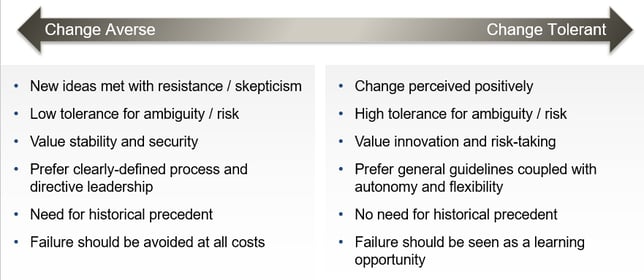This year, we are happy to update one of our 8 Dimensions of Culture. The Cultural Dimension formerly known as “Control” has morphed into “Change”, and now is a good time to share some more on this, well, change.
Why the Change to Change?
Based on feedback and specific input from clients, end users, and cultural experts, we found that many people were finding it difficult to understand how a person’s internal or external “locus of control” impacts workplace interactions, especially in a culturally diverse environment. Specifically, the language around “locus” and “control” created confusion. After reviewing the essence of the Dimension, we decided to choose a much simpler term: Change. This new name is easier to put into action, and it also translates more effectively into different languages.
What Describes the Change Dimension?
The Change Cultural Dimension refers to how open a culture is to change and how much control they believe they have over their workplaces and general environments.
In Change Averse cultures, people often prefer to maintain the status quo. Change may be seen as unnecessary or somewhat threatening. Change Averse individuals may believe that many things are beyond their control, and that avoiding risk is a good thing. This end of the Change Dimension spectrum would align more or less with the previously labeled “External Control” style.
In Change Tolerant cultures, people expect and anticipate change, and they may view it as a positive force or an opportunity for the better. Change Tolerant people often believe that they can control a wide range of personal and professional situations. Change Tolerant people tend to be receptive to new ideas and alternative ways of doing things. This end of the Change Dimension spectrum would align more or less with the previously labeled “Internal Control” style.

How Do I Recognize the Change Dimension in the Workplace?
Change Averse people may strive to maintain existing and/or traditional values and systems. They may perceive change with skepticism, which means that any change initiatives should be carefully managed. Introducing new systems requires well-planned implementation in order to overcome any skepticism or cynicism.
In Change Averse cultures, new ideas are frequently evaluated on the basis of risk, rather than potential opportunity. Leaders and other decision-makers may need to review precedents for the proposed change initiative in order to feel comfortable moving forward. When change does occur in Change Averse cultures, it tends to be in smaller increments, or it may represent a gradual evolution. Implementing new things may require extra time and effort to achieve the necessary buy-in.
Change Tolerant cultures pursue and embrace change and innovation. People with this value typically see change as an opportunity for improvement or growth. Risk-taking is often encouraged and rewarded, and failure is often viewed through a more optimistic lens and as a learning experience.
In Change Tolerant cultures, planning allows for flexibility and continuous refinement. Leaders are usually expected to be agents of change. Presentations and discussions will frequently focus on the potential opportunities that can come with change, rather than the possible negative risks.
Tips for Working Effectively Across Diverse Orientations to Change
If you are working with a more Change Averse culture…
- Don't expect your proposed changes to be readily embraced. Allow for additional time to develop understanding, acceptance, and implementation of a change initiative.
- Expect a slightly more resigned view of work. Change Averse people may not feel that they are fully in control over their destiny or the environment, which often means that they may be less willing to take risks, show initiative or embrace new ideas with your level of enthusiasm.
- To be inclusive of Change Averse people, consult with them when introducing new initiatives to learn about their needs. Factor these into your decision-making process, planning and implementation. Be prepared to listen and learn what works well for them based on their personal and cultural values.
- Change Averse professionals may be less likely to take charge of their own career management, and might assume that their career advancement is more contingent on connections, seniority, and length of tenure with the company than job performance.
- Junior staff will likely respond best to highly detailed, explicit rules, guidelines and instruction when it comes to new tasks, projects or processes.
If you are working with a more Change Tolerant culture…
- Change Tolerant professionals will likely embrace new products, systems or initiatives enthusiastically and will move forward with discussions and actions to bring the new idea to life, without needing to do deep due diligence.
- Accept that new business plans may be implemented quickly, without the amount of detailed planning you may expect. Also, recognize that there will probably be more stigma assigned to individuals who fail to take risks than there is to people who take risks and subsequently fail.
- Your employees will prefer for you to provide general guidelines and resources, then allow them the autonomy and flexibility to execute the task or project. Recognize that Change Tolerant individuals expect to control many aspects of their personal and professional environments.
- Expect higher job and geographical mobility and consequently less personal loyalty to one's employer. This person or culture will likely be prone to managing their own career than waiting for their supervisor to make a recommendation for promotion.
In our own effort to “walk the talk” of being more globally- and inclusively-minded, we hope this change makes it easier to use the Change Dimension as you attempt to bridge the differences you encounter with people near and far.


